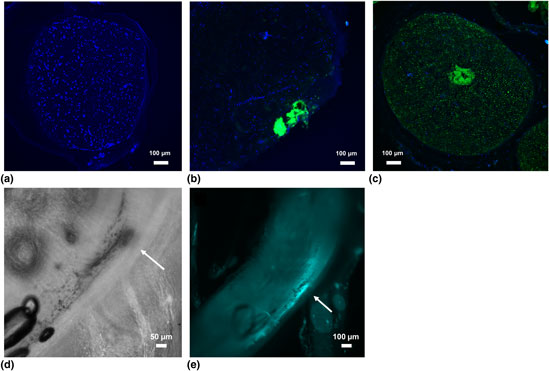Crossref Citations
This article has been cited by the following publications. This list is generated based on data provided by
Crossref.
Tomaskovic‐Crook, Eva
Zhang, Peikai
Ahtiainen, Annika
Kaisvuo, Heidi
Lee, Chong‐Yong
Beirne, Stephen
Aqrawe, Zaid
Svirskis, Darren
Hyttinen, Jari
Wallace, Gordon G.
Travas‐Sejdic, Jadranka
and
Crook, Jeremy M.
2019.
Human Neural Tissues from Neural Stem Cells Using Conductive Biogel and Printed Polymer Microelectrode Arrays for 3D Electrical Stimulation.
Advanced Healthcare Materials,
Vol. 8,
Issue. 15,
Kayser, Laure V.
and
Lipomi, Darren J.
2019.
Stretchable Conductive Polymers and Composites Based on PEDOT and PEDOT:PSS.
Advanced Materials,
Vol. 31,
Issue. 10,
Seo, Kyung Jin
Artoni, Pietro
Qiang, Yi
Zhong, Yiding
Han, Xun
Shi, Zhan
Yao, Wenhao
Fagiolini, Michela
and
Fang, Hui
2019.
Transparent, Flexible, Penetrating Microelectrode Arrays with Capabilities of Single‐Unit Electrophysiology.
Advanced Biosystems,
Vol. 3,
Issue. 3,
Lee, Seunghyeon
Ozlu, Busra
Eom, Taesik
Martin, David C.
and
Shim, Bong Sup
2020.
Electrically conducting polymers for bio-interfacing electronics: From neural and cardiac interfaces to bone and artificial tissue biomaterials.
Biosensors and Bioelectronics,
Vol. 170,
Issue. ,
p.
112620.
Haring, Alexander P.
and
Johnson, Blake N.
2020.
Organ-on-a-chip.
p.
215.
Tong, Yuxin
Feng, Ziang
Kim, Jongwoon
Robertson, John L.
Jia, Xiaoting
and
Johnson, Blake N.
2020.
3D printed stretchable triboelectric nanogenerator fibers and devices.
Nano Energy,
Vol. 75,
Issue. ,
p.
104973.
He, Guangwei
Dong, Xufeng
and
Qi, Min
2020.
From the perspective of material science: a review of flexible electrodes for brain-computer interface.
Materials Research Express,
Vol. 7,
Issue. 10,
p.
102001.
Subramanian, Vivek
and
Martin, David C.
2021.
In Situ Observations of Nanofibril Nucleation and Growth during the Electrochemical Polymerization of Poly(3,4-ethylenedioxythiophene) Using Liquid-Phase Transmission Electron Microscopy.
Nano Letters,
Vol. 21,
Issue. 21,
p.
9077.
Subramanian, Vivek
and
Martin, David C.
2021.
Direct Observation of Liquid-to-Solid Phase Transformations during the Electrochemical Deposition of Poly(3,4-ethylenedioxythiophene) (PEDOT) by Liquid-Phase Transmission Electron Microscopy (LPTEM).
Macromolecules,
Vol. 54,
Issue. 14,
p.
6956.
Karazehir, Tolga
Sarac, Baran
Gilsing, Hans-Detlev
Gumrukcu, Selin
Eckert, Jürgen
and
Sarac, A. Sezai
2021.
Functionalized highly electron-rich redox-active electropolymerized 3,4-propylenedioxythiophenes as precursors and targets for bioelectronics and supercapacitors.
Molecular Systems Design & Engineering,
Vol. 6,
Issue. 3,
p.
214.
Liang, Yuanying
Offenhäusser, Andreas
Ingebrandt, Sven
and
Mayer, Dirk
2021.
PEDOT:PSS‐Based Bioelectronic Devices for Recording and Modulation of Electrophysiological and Biochemical Cell Signals.
Advanced Healthcare Materials,
Vol. 10,
Issue. 11,
Tan, Shu Fen
Reidy, Kate
Lee, Serin
Klein, Julian
Schneider, Nicholas M.
Lee, Hae Yeon
and
Ross, Frances M.
2021.
Multilayer Graphene—A Promising Electrode Material in Liquid Cell Electrochemistry.
Advanced Functional Materials,
Vol. 31,
Issue. 46,
Dimov, Ivan B.
Moser, Maximilian
Malliaras, George G.
and
McCulloch, Iain
2022.
Semiconducting Polymers for Neural Applications.
Chemical Reviews,
Vol. 122,
Issue. 4,
p.
4356.
Lee, Junghyun
Chhatre, Shrirang
Sitarik, Peter
Wu, Yuhang
Baugh, Quintin
and
Martin, David C.
2022.
Electrochemical Fabrication and Characterization of Organic Electrochemical Transistors Using poly(3,4-ethylenedioxythiophene) with Various Counterions.
ACS Applied Materials & Interfaces,
Vol. 14,
Issue. 37,
p.
42289.
Chen, Hai-lan
Yang, Dan
Chen, Chun-rong
Tian, Guang-zhao
and
Kim, Dong-Hwan
2022.
In situ polymerization of conducting polymers around living neural cells: Cellular effect study.
Colloids and Surfaces B: Biointerfaces,
Vol. 213,
Issue. ,
p.
112410.
Ciccone, Giuseppe
Cucchi, Matteo
Gao, Yanfei
Kumar, Ankush
Seifert, Lennart Maximilian
Weissbach, Anton
Tseng, Hsin
Kleemann, Hans
Alibart, Fabien
and
Leo, Karl
2022.
Growth and design strategies of organic dendritic networks.
Discover Materials,
Vol. 2,
Issue. 1,
Qin, Yinhua
Fan, Yonghong
Chen, Ruyue
Yin, Haiyan
Zou, Hao
Qu, Xiaohang
Tan, Ju
Xu, Youqian
and
Zhu, Chuhong
2022.
Harnessing Oxidative Microenvironment for In Vivo Synthesis of Subcellular Conductive Polymer Microesicles Enhances Nerve Reconstruction.
Nano Letters,
Vol. 22,
Issue. 9,
p.
3825.
Cucchi, Matteo
Parker, Daniela
Stavrinidou, Eleni
Gkoupidenis, Paschalis
and
Kleemann, Hans
2023.
In Liquido Computation with Electrochemical Transistors and Mixed Conductors for Intelligent Bioelectronics.
Advanced Materials,
p.
2209516.
Niederhoffer, Thomas
Vanhoestenberghe, Anne
and
Lancashire, Henry T
2023.
Methods of poly(3,4)-ethylenedioxithiophene (PEDOT) electrodeposition on metal electrodes for neural stimulation and recording.
Journal of Neural Engineering,
Vol. 20,
Issue. 1,
p.
011002.
Lu, Zixuan
Pavia, Aimie
Savva, Achilleas
Kergoat, Loig
and
Owens, Róisín M.
2023.
Organic microelectrode arrays for bioelectronic applications.
Materials Science and Engineering: R: Reports,
Vol. 153,
Issue. ,
p.
100726.






